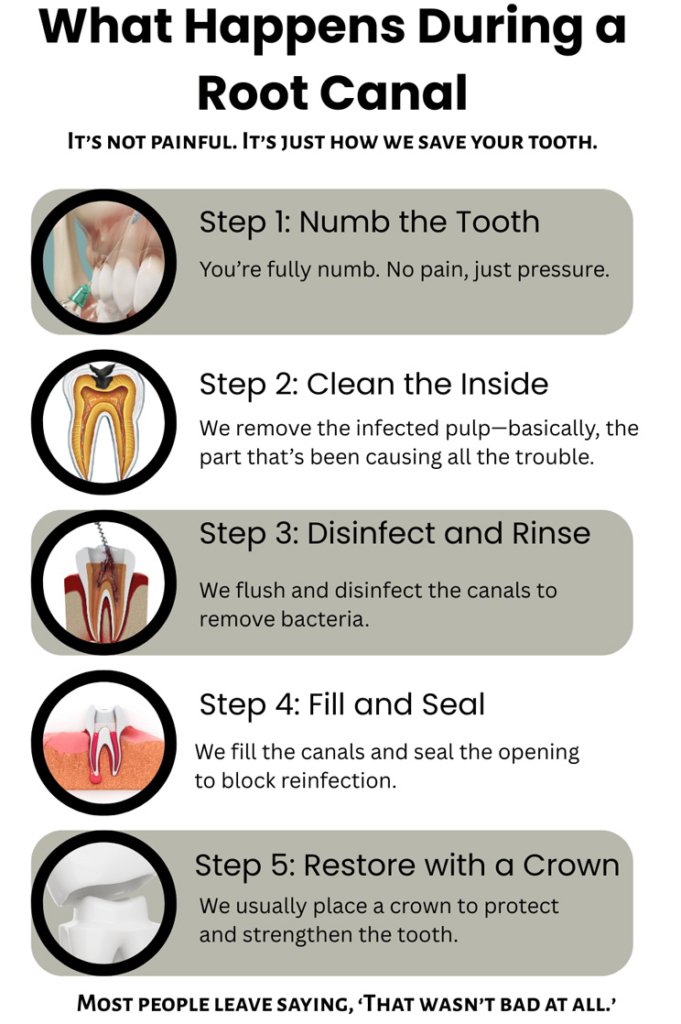
May 27, 2025
Let’s talk about root canals—the dental procedure with the worst PR in history.
Somehow, over time, “root canal” became shorthand for something terrible you have to suffer through. But in reality? It’s not even close to the horror story people imagine. In fact, getting a root canal is often the relief after a long bout of pain. It’s the calm after the storm.
Let me explain it the way I would to a good friend over coffee (minus the creamer and cavity risk).

Your tooth is like a little apartment. On the outside, it looks solid and polished. But inside, there’s a whole setup—nerves, blood vessels, and soft tissue called the pulp. When everything’s healthy, this inner world just minds its own business.
But if decay sets in deep enough—or you’ve had trauma, a cracked tooth, or a really deep filling—that pulp can get irritated, inflamed, or infected. And once it’s infected, it’s not bouncing back. The bacteria have basically set up camp, and the body can’t get rid of them on its own.
A root canal is how we evict the troublemakers, clean out the mess they left behind, and seal up the space so they can’t come back.

You might notice:
Sometimes there are no obvious signs—until we catch the infection on an X-ray. Think of it like mold in the walls: you may not see it right away, but it’s quietly spreading, and if we don’t catch it early, it causes much bigger problems later.
First, the tooth is numbed completely. You’ll feel pressure, but no pain. The reputation of the root canal being a nightmare is about 30 years outdated—it’s like being afraid of your smartphone because you once had a flip phone that dropped calls in 2003.
Once you’re numb, we:

Later, in most cases, we’ll top it off with a crown— in order to get to the inner layer of the tooth, we have to make a channel through the tooth. After we make this channel, the tooth could break during the side to side chewing movements we use to eat our food. This is why we strengthen the tooth with a protective covering we call a crown.
If you’re in your 20s and haven’t had your wisdom teeth evaluated yet, now is the time. Just because they’re not causing pain doesn’t mean they’re not causing harm.
You’ll want to avoid chewing hard foods on that side until we finish restoring the tooth with a permanent crown. But otherwise, life goes on as normal.
You can pull it. But then you have a space. And that space will eventually cause shifting, biting problems, and bone loss in the area. Replacing a tooth with a bridge or dental implant is totally doable—but more expensive, more involved, and still not as good as keeping your own tooth when we can.
It’s like asking if you should just knock down the whole house because you found mold in the bathroom. You could, but… it’s a little extreme, right?
Root canals don’t cause pain—they relieve it. They’re one of the best ways to stop an infection in its tracks and save your natural tooth.
I know the name sounds dramatic. But the actual experience? Most patients say, “That’s it?” And I nod, because yeah—that’s it.
If you’ve been told you might need one, don’t panic. It doesn’t mean your tooth is doomed—it means we’ve got a way to rescue it before it is.
| M | T | W | T | F | S | S |
|---|---|---|---|---|---|---|
| 1 | 2 | 3 | 4 | 5 | ||
| 6 | 7 | 8 | 9 | 10 | 11 | 12 |
| 13 | 14 | 15 | 16 | 17 | 18 | 19 |
| 20 | 21 | 22 | 23 | 24 | 25 | 26 |
| 27 | 28 | 29 | 30 | 31 | ||
